Dealing with rats when you have chickens
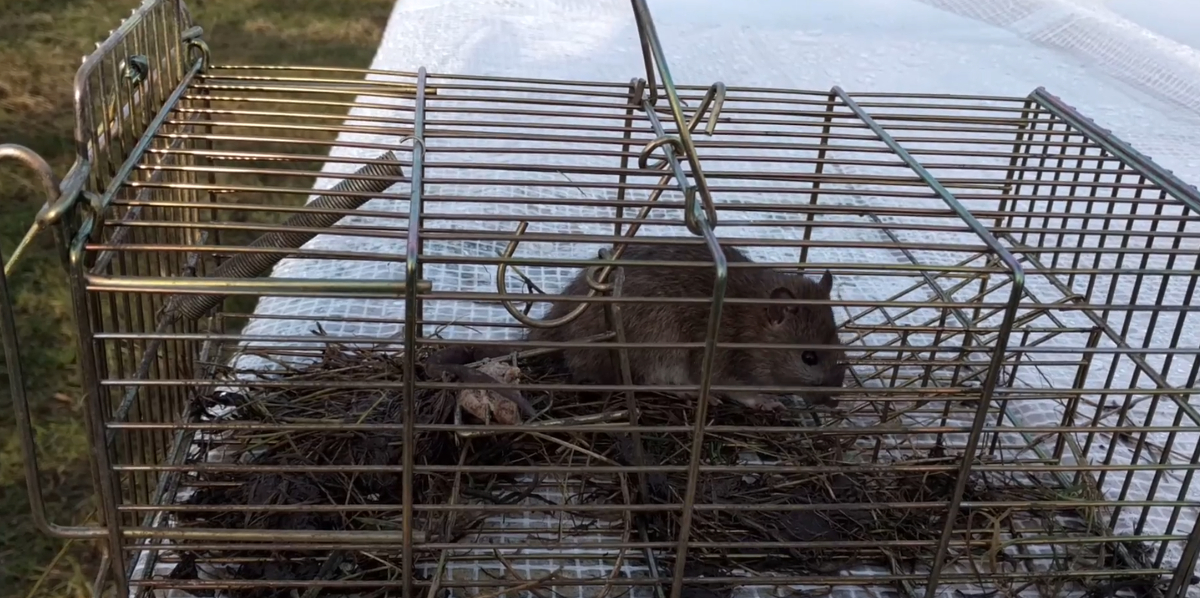
The complete chicken keepers guide to dealing with rats. With all the rat traps tested. This article may not be for the faint hearted.
Table of Contents
- Do rats harm chickens?
- The law and rats:
- Why are rodents controlled?
- Do chicken coops attract rats?
- How do you know if you have rats?
- How do you deal with rats?
- The damage that rats do:
- What precautions should you take when dealing with rodents?
- What if you already have an infestation of rats?
- Preventing Rats in the Chicken Coop:
- How do you Kill, catch or trap rats?
- Poison:
- How long does it take for rodents to die from poison?
- Is there a safe poison for use around chickens?
- Classic snap traps:
- What is the best bait for rats?
- Get a cat:
- Dogs, or more specifically, Terriers.
- Guns, more specifically air rifles.
- Gas powered trap and refills:
- Electric traps or Electrocution rat traps:
- Home made rat traps:
- Glue traps or Glue boards:
- Humane rat traps.
- How do you kill a rat?
- Nest breaking:
- Repellents:
- Which rat traps should I avoid?
- What home remedy can I use to get rid of rats?
- How do you dispose of dead rats and mice?
- Should you use a pest control agency or do it yourself?
- How do rats carry chicken eggs?
- Do treadle feeders work for rats?
- Conclusion:
What if I told you that you could save 20% on your chicken feed almost overnight. Well it is estimated that rats and mice consume or spoil 20% of the food produced worldwide and you can bet that you are losing a percentage of your chicken feed to vermin.
There are good reasons why you should try to eliminate rats around your chicken coop and run, they carry disease and can make your flock, and you ill. Rodents will eat the chickens feed, drink their water and shelter in their housing.
Below: Rats will eat eggs, chicks and kill chickens, even full grown ones.

Rats they tend to defecate and urinate wherever they are and that contaminates every surface they touch.
The best way to deal with rats is to treat the problem with a multi pronged attack long before it becomes an infestation. Just because you keep chickens doesn't have to mean rats become as inevitable as death and taxes.
Wherever a rodent can get their nuzzle in a hole or crack, they can normally compress their body through it. Mice can get into homes by holes just 1/4-inch large.
Rats can get through holes as small as a quarter or smaller than a 50 pence piece if you live in the UK.
Both rats and mice can climb almost any surface, including trees and run along cables to get into from higher up through vent holes or roofs. Rodents are excellent climbers that use pipes, electrical wires, clinging vines, and walls to gain access to a building.
Rodents enter structures and build nests, store food which then rots, and cause damage to clothing, mattresses, and other household materials they utilise for nesting.
Do rats harm chickens?
Yes is the simple answer, chickens can catch diseases from rats and will kill and eat chicks and young birds and even adults.
It's important to emphasise the words "can be" and "infected" here and not to over-dramatise the scale of the problem.
Every rat or mouse has the potential to transmit these diseases and not every chicken or every human will catch them. They are however quite nasty and are best avoided.
Carriers of lice, fleas, mites and other parasites
The bacteria Salmonella can be carried by rats and mice. It's transmitted to chickens through drinking water which contains rodent faeces and urine.
Contact with infected rat urine in straw, feed or water can cause the bacterial infection Leptospirosis, also known as Weil's Disease. In humans it can enter the body through broken skin or through mucus membranes, such as those found in the nose.
The Bubonic Plague. The fleas that the rat carries transmits the disease. There a few cases of it in the US every year. So that's something to think about
Common house mice are the carriers of a virus which causes Lymphocytic Choriomeningitis. It's found in the saliva, urine and droppings of infected rodents. It's thought that around 5% of house mice in North America are carriers, although they won't necessarily show any signs of infection. It's most often contracted by breathing in dust when clearing away animal bedding.
A rodent has to be infected itself before it can pass on any infection.
Most illnesses caused by rodents won't leave lasting damage in a normal, healthy individual.
But they can be very serious for vulnerable groups, such as the very old, the very young, people whose immune systems are low and pregnant woman.
The law and rats:
I have cited UK legislation I have found similar laws in most countries I have looked at.
In most parts of the world there is a duty of care to livestock and that includes dealing with vermin. In some places it is a criminal offence to not deal with vermin and rats and you could end up being held responsible. In the UK this piece of legislation is the The Pests Act of 1954.
It is also illegal to keep or release rats as well as some other species, that have been caught alive in traps in most places that I know. It is illegal to use traps that are designed to catch animals by the legs.
Here in the United Kingdom the rat is one of the few pests that private homeowners can have disposed of at public expense. Local authorities will come out to trap, kill or poison rats for you.
Otherwise, you are free to dispose of them however you wish, so long as you do not cause them undue suffering - such as catching them by the feet.
It's good practice whether using lethal or non-lethal methods to do so humanely and prevent unnecessary suffering. The ideal is to control infestations without causing fear or pain.
In the UK the treatment and welfare of captured rodents is covered by the Animal Welfare Act 2006.
You should also make sure that traps are checked regularly and that you are not catching animals that you should not be.
Below: This Robin took a liking to Nutella bait and I had to move the trap after catching him 3 days in a row.
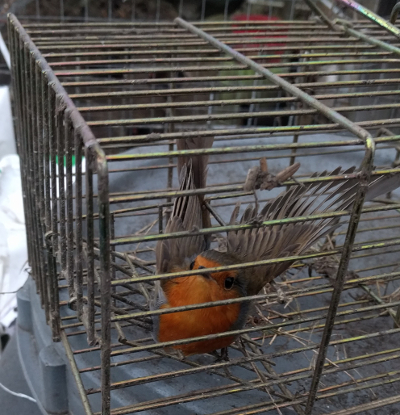
Why are rodents controlled?
Most of the 2000 or so species of rodents in the world cause no problems to humans. A few species of mostly rats and mice present problems.
Rodents are controlled for various reasons :
- Prevention of disease in humans and livestock.
- Loss or damage to growing and stored food.
- Structural damage to property such as chewing and tunnels undermining structures.
- Introduced rodents can decimate local animals.
- Social problems with rat and mouse infestations.
- Legal requirement to control vermin.
Rats carry some nasty diseases that are best avoided like Weil's disease and the plague.
Rats are such a problem because they carry disease and can make you or your flock ill. When rodents eat feed, they tend to defecate in it. Your chickens may ingest the faeces and that can make your flock ill with salmonella or other bacteria.
Second, rats will eat eggs and kill young birds. Rats will generally only prey on chicks and eggs, but if you have a serious infestation and food is scarce, they can also raid your coop at night and attack your juvenile and adult birds. Rats kill by biting the head or neck, like those from the weasel family.
Parts of your chickens' bodies may be eaten, and the corpses may be pulled into burrows or other concealed locations for feeding. Sometimes they are just dragged into a corner.
Do chicken coops attract rats?
You won't necessarily get rats just because you keep chickens.
It is not the chickens or the coop on it's own that attract vermin, it is the feed, water and shelter that rats and mice find irresistible.
Chicken feed will attract rats, that's why it's so important that you store your feed in metal bins and prepare your chicken run using a heavy gauge half-inch or less hardware cloth material.
How do you know if you have rats?
Rats tend to nocturnal, shy and frightened or wary of new things in their space. They come out more often at night or when nobody is around and if you see one in the day you can bet there are a lot more around nearby.
You will know you have them if:
- Trails
- Rat droppings
- Chewing
- Missing chicks
- Missing toes
- Feed being lost
- Missing eggs
Rats are creatures of habit and will leave marks or trials as the move around. They always use the same routes they have done in the past.
Below: Rats runs or trails in the snow. Also look for holes and worn paths.
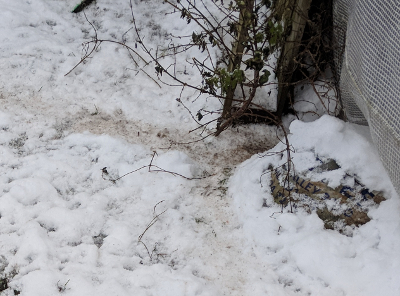
If you look carefully you can see a track that runs from the corner of the pen towards the bottom left corner of the picture. Rat runs usually follow straight lines.
Rat droppings are a giveaway and are very different from mouse poop. They're bigger, quite long and more jelly-bean shaped, being blunt or rounded at each end, and a similar size.
Below: Rodent dropping compared.

Mouse droppings, on the other hand, look like little black grains of rice. They're much smaller and they're pointy at both ends.
They're different in the way they're deposited as well, mice tend to poop all over the place as they wander about whereas rat droppings tend to be more isolated as rats tend use specific areas as a rat toilets.
Chewing damage. If your coop has no way in rats will chew their way in. Wood and plastic are no obstacle to rats and they'll chew right through them. Gnawed corners and doors are a telltale sign that you have rats. Their teeth are sharp and grow constantly and they have to gnaw to keep them worn down.
Below: Rats need to gnaw all the time and will chew through wood easily.
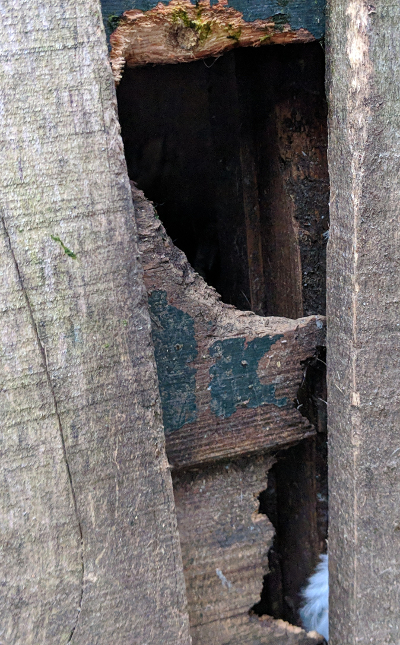
Holes in the floor of your coop or ground of your run. Rats are great burrowers and can enter your coop or run from below. Holes are usually two to three inches in diameter.
Missing chicks - They will drag chicks from under mother hens in the dark.
Missing toes - Rats will chew the toes off sleeping chickens.
Missing feed. Chickens consume an average of a quarter pound of feed per day. This can vary pretty widely depending on the season and the size of your bird but if you have ten average chickens and you're going through a fifty-pound bag of feed every week, then it's safe to assume something other than your chickens is helping themselves.
Missing eggs. If you're getting fewer eggs than you expect consider that rats may be the problem as like humans they love a fresh egg.
It's easy to tell the difference between an adult rat and a mouse, a rat is much bigger. But it can be very difficult to tell the difference between a mouse and a baby rat as they're about the same size. There are subtle differences in shape and ear size, it's hard for a person without specialist knowledge to tell them apart.
You may not see any rats unless you have a severe problem.
How do you deal with rats?
They multiply very rapidly and are capable of having litters every 2 months, and their offspring reach sexual maturity in as little as 6 weeks. Some sense of urgency is required.
Below: A nest of young rats I caught just in time.
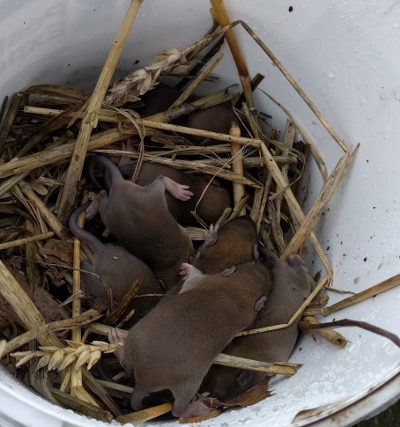
You deal with rats by removing their food and water sources, depriving them of shelter and by killing by a variety of methods.
It is likely that many chicken keepers do not know they have rats mooching around at night and sometimes during the day as well. As with all chicken keeping problems if you can prevent the problem by taking away the feed, water and shelter from rats at night then they will never become a problem.
Some are quick to criticise chicken keepers but people feeding wild birds in their back garden are as likely to have rats and vermin as chicken keepers.
Remember rats come for :
- Food. Rats will eat the chickens, the chicks, the feed and the eggs
- Water. Every animal need a supply of water.
- Shelter. Modern gardens are obligingly filled with sheds and hiding places. If you have a compost heap, log pile shed, coop or stored materials will have hiding places for rats.
Deter rats by:
- Removing feed and water at night.
- Not having piles of rubbish for them to nest in.
- Using a solid weld mesh around the coop. Their teeth can cut through ordinary chicken wire in a flash.
- Collecting the eggs every day.
- Getting a cat.
- Keeping the coop and run clean.
If you make their lives difficult they will move on rather than stay.
The damage that rats do:
- Gnawing - they chew all the time to wear down their constantly growing teeth. They can destroy the structure of a coop in no time.
- Digging tunnels and nests and undermining the ground.
- Spread disease, dribble urine and defecate everywhere.
- Eat and contaminate feed.
- Kill chicks and sometimes chickens.
- Upset the neighbours.
You need to be aware that in most countries it is a criminal offence to release rats or not to deal with infestations.
What precautions should you take when dealing with rodents?
If you're not sure whether you have rats or mice, take precautions anyway whenever you're cleaning your coop. Cover your mouth with a mask.
It may sound obvious but handle poisons with great care and account for what you use so none is mislaid.
Below: Handle dead rodents with litter pickers.
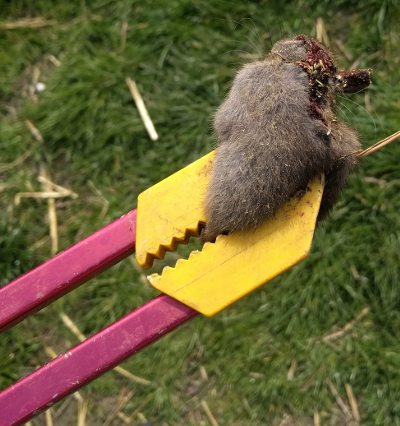
Dead animals should be handled with litter pickers, double bagged, sealed with tie wraps and put in the garbage unless your local laws say otherwise.
Live rats have a nasty bite so mind where you put your fingers.
What if you already have an infestation of rats?
If you have livestock, you will have rats and mice. You just need to do everything you can do to control their numbers.
There are a few measures you can take:
Firstly remove the feeders and waterers each night and replace them in the morning until the problem is taken care of. While your chickens won't want to eat or drink at night, rats will! Why remove waterers as well? In dry areas or during dry periods, rats may come just for the water. It's just better not to leave anything attractive out for them at night.
How do you get rid of rats in your chicken coop? the best way to control rats is to cut off three essential things for them to survive food, water and shelter.
Apron fencing with a sturdy weld-mesh. Chicken wire wont keep them out.
If you see gnawing damage on your coop, staple wire wool, hardware cloth or secure sheet metal to the damaged areas to keep them out.
Of course, trapping rats is another great way to temporarily eliminate an infestation.
Use poison. It is effective and one weapon in the armoury. Poison is especially effective when you remove all other feed and the rats are forced to eat large doses at once.
Use a rat trap, and make sure it's in a place where your chickens and other animals can't accidentally get hurt by it.
In summary, avoid attracting rats to begin with. If you do encounter a problem, traps and exclusion are usually the best ideas.
Preventing Rats in the Chicken Coop:
Because rats are first and foremost attracted to the chickens feed and water, it is important that you make a conscious effort to minimise food waste and attempt to place food sources out of their reach. Some easy fixes include:
Clean up any spilled feed before nightfall.
Store feed away from the coop. Keep it in a airtight container like a feed drum with the lid always firmly in place.
Remove or securely cover feeders and water source at night.
Invest in a treadle feeder to keep your feed secure.
Rats also love to feast on your girls beloved eggs. To avoid this problem make sure that all eggs are collected from the coop each night.
Perhaps the most important preventative measures you can take to help keep your feathered friends safe is with the chicken coop itself. There a number of features that you should be sure your chicken coop has to help keep these pesky pests at bay.
Make sure that your coop is fitted with a sturdy 10mm x 10mm galvanised wire mesh that is fixed firmly in place - ordinary chicken wire will not cut it!
High quality locks, sliding bolts and padlocks should be installed-not flimsy twist closes, to keep rats from pushing their way in
Nesting boxes should be elevated to keep your girls eggs out of their jaws and reach
Rats love to gnaw on everything, so make sure your coop is made with a high quality, weather resistant timber that is painted, this will make it extra difficult for even the strongest of rats to chew their way in!
How do you Kill, catch or trap rats?
The reality of rats being highly mobile survivors is you will probably need to use more than one method and trap and kill all the time to prevent them getting a foothold.
I have tested and used all of these methods. I always use more than 1 method at the same time.
Poison:
Poisoning is an effective means of extermination but tends not to be a long-term solution as the rodents get used to it and begin to avoid the bait.
Use gloves and be careful with poison. Make sure your birds cant get hold of it.
Baits need to be rotated as the rats will develop immunity and get used to them.
There are many different poisons on the market, blocks, pastes and grains.
Tips for poisoning rats:
- Clearly mark your bait box so that anyone who sees it knows that it contains poison and will leave it alone.
- When you first put poison down for rats, they will be cautious and probably give it a wide berth for a while, so don’t be surprised if it takes up to a week before you notice the poison has been eaten.
- You get what you pay for when it comes to poisons so expect better results if you buy a decent poison from an agricultural store than you would from using a budget brand control poison from the local dollar store.
- You don’t need to overload your bait box; a little bit and often is the way to go!
- Rats are pretty dirty and poison is pretty dangerous, so it’s not a bad idea to wear gloves when checking and topping up your bait box or removing any dead rats you find.
- Rats develop resistances to poisons pretty fast. If your poisoning campaign doesn’t seem to be having any effect despite the poison being eaten try changing the brand and type of poison you are using.
- Poison is dangerous if not treated with respect, handle it with care and always be mindful of the effect it can have on other animals. Always make sure your bait box is secure and take extra measures if dogs, cats or children might be in the vicinity. Check your bait boxes regularly and look for signs of other animals being attracted to them and take any appropriate action to make sure they are safe.
- During your poisoning campaign you should look for and dispose of any rat corpses so that residue poison does not affect any local wildlife.
- Dispose of corpses properly.
- Rotate poison types and brands so as they do not get used to it.
- Use a poison with the active ingredients - Bromadiolone 0.0025% w/w & denatonium benzoate 0.001% w/w . I use the brand RODEX here in the UK. It comes in handy sachets so you do not need to touch the bait and is coloured with a dye so you can see that it is being eaten. Buy Rodex at amazon.co.uk . or buy rat poisons at amazon.com
Whether poison should be a first or last resort is always a question people ask.
It's an unpleasant death for the rat, potentially dangerous for pets, livestock and people and not a topic to be taken lightly.
How do rats become resistant to poison?
The practice of purposely ingesting poisons to build up immunity to them is called mithridatism. Although rats do not do this on purpose as we feed them the bait.
When rats nibble just a little bit of rat bait, but not enough to kill them they gradually become immune to the bait.
Stronger poisons are being developed but all rats develop some resistance over to those poisons if they are not killed by them. In the UK it is estimated up to 75% of the rats are resistant to at least one poison.
How long does it take for rodents to die from poison?
Most poisons are anticoagulants and they are highly effective provided the dose is suitably large. It can take 2 to 4 days to kill a rat and they need to eat enough to kill them in one go as if they recover they will never eat baits again.
A decent dose will kill in 24 hours.
Is there a safe poison for use around chickens?
No. Poisons are not safe. A dose that will kill a rat will kill a chicken.
Chickens pecking at rats after they have died from poison can cause secondary poisoning as well.
Animals you want to keep must be kept separate from poisons.
Classic snap traps:
The spring loaded classic rat or snap trap has historically been the first method people turn to when they need to kill rats.
Below: a Powerful rat killing snap trap.

Spring-powered killing traps, either mounted on pressed steel or a piece of wood or a two part snapper. They are easy to use, quick and effective, but messy. The law says they should be the appropriate size and power to kill the target animal.
How to use snap or clasp traps.
Set snap traps in places where you know the rodents are moving, usually around the edge of a run or an outbuilding. They may need to be in place for a week or two before you catch anything as rats are wary or unsure of new things in their space.
Below: This is a pressed steel snap trap.
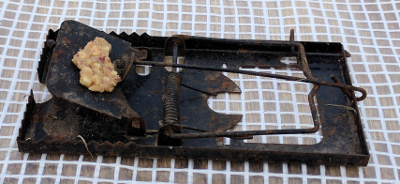
This is one of four I have that have seen many years of action.
Below: They also come in the classic style with a wooden base.
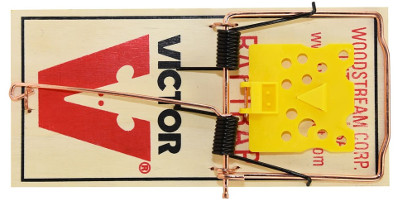
You can buy these traps cheaply on amazon.co.uk - 10 pack.
Or amazon.com - 12 pack.
Handle snap traps as little as possible or use gloves to keep you smell off the trap.
Place them well out of the reach of your children, chickens or other animals.
Leave them there for several days, baited but not set until the rodents get used to them. Rats are cautious creatures and won't go near something new and unknown.
Cheese is not the best bait but it does work. Nutella or peanut butter is better. Rats are attracted by the smell and you'll only need a tiny smear.
Advantages: Cheap, easy to set up, even with multiple traps and normally very quick to kill, so the rodent doesn't suffer unduly.
Disadvantages: Can break fingers if your not careful.
Due to their small size, these are better suited to mice than rats. Sometimes even the large size traps don't kill rats effectively and the traps can be dragged away.
Having to empty the traps of decapitated creatures.
Rodents are actually intelligent animals and will learn not to go near traps which they've seen to be harmful to their community. You need to change them, try different baits and move them around often.
What is the best bait for rats?
Common sense suggest you first try whatever you are feeding the chickens as that is what the rats came for in the first place. Whole grains can be stuck to the release mechanism with peanut butter.
The best rodent baits are peanut butter and Nutella. Raisins and cake work as well as do most fats like butter and proteins like burgers.
Get a cat:
Not an option for everyone and you need the right kind of cat! I live in rural Yorkshire where, farmyard, stray and semi-feral cats are common.
If you're thinking of getting a cat to keep control of the mouse or rat population it really needs to be a large feral or barnyard-type animal which is used to living outside and has been taught by its mother how to tackle the problem.
Most smaller, domesticated cats are unlikely to have the courage to take on a full-grown rat.
Be careful, though, about how any cat reacts with chickens. It's fairly common for cats to kill baby chicks - after all, to a cat they look just like birds - and some will even take on full-grown hens.
Dogs, or more specifically, Terriers.
Below: These are plummers terriers killing rats.
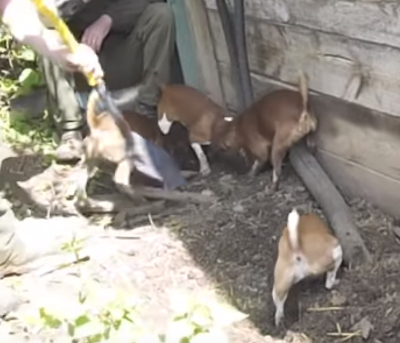
Terrier clubs to come into the site once a month, sometimes after dark, and let their dogs loose in the yards where the rats were running. Watching the dogs 'at work' was mesmerising!
This is a picture showing terriers killing rats on a farm in the UK.
Advantages: Terriers are bred for this kind of work and love doing it.
It's a quick death for the rat - the dogs are fast to catch them and shake them to death.
This is a process still used on many farms where these dogs are kept for this specific purpose.
Very effective in the short-term for clearing infestations.
Disadvantages: Needs doing regularly. The dogs will only catch rats which are running, so babies will be left in the nest unless it's found and cleared.
You need to find a terrier owner or club near you!
Guns, more specifically air rifles.
You don't need to own a weapon or undertake this yourself, there are loads of shooting clubs that will happily use rats as target practice for air rifles. There are many members of rifle clubs who will happily come and shoot rats for a few hours in your garden or backyard.
Below: Me shooting rats at night with a .177and a night sight.

Even if you do it yourself you don't need anything more than a air rifle.
Is it perfectly legal and it does it work?
Yes, Although in the UK and Europe personal use of firearms without a certificate is illegal, it is perfectly legal anywhere to shoot vermin, as long as it's on your own land and using an air rifle below a certain power level.
If you have permission, it's also legal to shoot rodents on someone else's land.
Advantages: Quick, simple and useful when dealing with rats caught in cage traps or home made barrel traps.
Rats trapped in open buildings are literally a sitting target.
Bringing rats to one place is easy if you lay bait down. Nutella, peanut butter or diced up cat food works well.
Disadvantages: Requires accuracy as poor aim leads to suffering animals.
Rats generally like to come out at night, so you need to set up just before dusk to be most effective or use night sights.
Shooting by artificial light isn't a good idea - the rats will simply remain in their nest.
Gas powered trap and refills:
In the UK this is the Goodnature trap. Powered by gas cylinders. Not safe to use around chickens, they can get their heads inside the trap. The bait is not always as attractive to rats as the marketing would suggest.
Below: A goodnature rodent killer in action.

These are automatic humane traps. They are small, easy to install and dispatch rodents humanely and efficiently every time.
They contain a bait marketed as a long-life formula for rats. The trap is powered by compressed air and once triggered the rat has it skull crushed instantly and the pest falls from the trap which immediately resets itself. Capable of controlling up to 24 rodents per CO2 canister.
Having used one of these I can say they are excellent, ruthlessly effective but expensive. The basic package is nearly £5 or $7 per rat. If you buy in bulk the cost comes down but it still bottoms out at around £3 or $4 a kill.
Electric traps or Electrocution rat traps:
These devices deliver an electric shock to the mouse or rat that enters them which causes death by causing cardiac arrest.
Below: The Victor electric rodent trap.
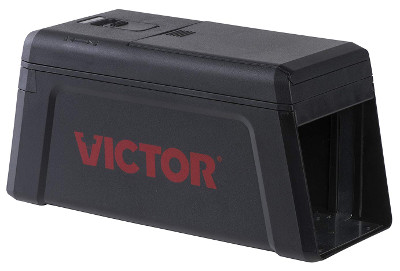
These traps are powered by battery. The rat is enticed into the box by bait, steps on a metal plate. This triggers an electric shock which kills instantly.
Advantages: It's relatively quick and the rat is killed without blood being spilled, which makes cleaning up easy. More than 1 can be killed overnight for example.
It's also impossible for pets or poultry to fit inside, so they're safe for other animals. And they don't harm the environment.
For those reasons, this is my preferred method of rodent control. I've found these traps very effective for controlling both rats and mice - in the house and garage as well as in my chicken coop.
Disadvantages: The humaneness of these devices will depend upon whether sufficient current runs through the brain and for long enough to cause immediate loss of consciousness from which the animal will not recover prior to death. Make sure you charge or renew the batteries regularly.
Home made rat traps:
Amusing watch on YouTube but not so amusing to use in reality.
Below: a homemade mouse trap.
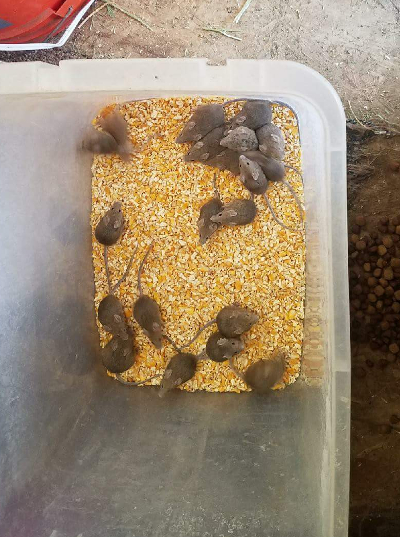
The trouble is unless you fill the trap with water you have to deal with the live rats or mouse.
Some are dangerous, some imaginative, some downright quirky. One of the most common is the 'walk the plank' option. Take a barrel, fill to about 6" with water. Add some grain or bait and add a smear of peanut butter at the edge of the plank.
On top of the barrel balance a plank, one end hovering over the centre of the barrel and the rats 'walk the plank' to get to the peanut butter, topple into the water and drown.
Advantages: Inexpensive.
Disadvantages: Unpredictable - you need to be sure the plank will stay in place.
Inhumane - it will take several minutes for a rat to drown.
Not always effective, according to people who have used it.
Glue traps or Glue boards:
They're literally pads of glue which are set in rat-run places. When rodents, or anything else, moves across them, they find themselves stuck fast.
This is the only method which I do not use. It was inhumane and cruel.
These are what their name suggests: boards covered in a viscous glue. Animals stick to these boards and unless killed, will die, probably slowly, as a result of injuries, starvation, dehydration, exposure or suffocation.
Advantages: Cheap, easy to use and non-toxic and therefore may be seen as advantageous in some food processing industry.
Disadvantages: They catch anything moving across them, including insects and birds. Unless animals that become stuck on glue boards are promptly killed using a humane method , they will be at increasing risk of injuries associated with escape attempts, starvation, dehydration, exposure (and possible injury through aggression from other animals), or suffocation if their muzzles become stuck in the glue.
Because it is perceived that there is a high risk of severe welfare consequences, Mason and Littin (2003) state that they tend to be avoided by responsible pest control operatives.
Glue boards should only be used when they can be checked very frequently to avoid the above risks (at the very least twice daily).
Used mainly by commercial companies because they're cheap and very effective.
The animal either dies from panic, exhaustion trying to escape, starves to death or has to be killed manually.
I don't normally oppose any method of dealing with rats but I would say, having seen these first-hand, that I do not think they should be used.
Humane rat traps.
Kind - but the rats may well return. And now you have a very annoyed live rat in a cage on your hands. So what are you going to do with it?
Below: a Sturdy well constructed example of a humane cage trap.

Mostly metal cage traps but there are other designs. The rodent is caught inside, triggering the door to close. The rodent then has to be re-located which is illegal in most places as you are not allowed to release pests.
The best humane traps are made of metal. Plastic is no good, even mice can gnaw through plastic a matter of minutes. Rats will take seconds.
If the idea of killing any living being is difficult for you then this is the only real option as it doesn't harm either the rat or any other animal which happens along.
Rats are territorial animals and once they set up home they like to stay there. If you release the rats within 1 or 2 miles to your coop they will return in a day or so.
The advice is to release the rat at least five miles away from your home before setting it free and now you have just made it someone else's problem by letting it go on their land.
The reality of the humane method is if this is your choice then you should probably get a pest controller in.
How do you kill a rat?
The Wild Mammals Protection Act 1996 requires when for pest control, animals should be killed in a reasonably swift and humane manner.
I do understand that many people may find that humane killing is not an easy procedure.
The following methods are considered to be humane:
- Destruction of the brain by a strong and accurate blow to the head with a suitable implement.
- Lethal overdose of appropriate gaseous or injectable anaesthetic (this technology is not available for general use).
- Destruction of the brain by shooting.
After killing, regardless of method used, it is very important to confirm death. The important sign to check is:
- No breathing or other movement.
- No blink reflex if the surface of the eye is gently touched with a soft implement (eg a feather, straw, cotton-bud stick).
- No reaction to a sharp pinch of the soft tissue of a paw.
- No heart beat.
If there is any suspicion that an animal might still be alive, the killing procedure should be repeated immediately taking care to ensure it is effective.
Nest breaking:
I use this method all the time. I have a dirty little corner with feed and water and some mess to give cover and then every three weeks turn it over and kill the babies in the nests.
Below: A nest of naked young baby rats.

Catch rats before they become a problem.
Repellents:
Ultrasonic repellents:
I think these are wishful thinking but there are no scientific studies at all which have found them to be effective in getting rid of rats and manufacturers have been repeatedly warned not to make false claims by the Federal Trade Commission of America.
Below: an ultrasonic rat repeller.

Rats and mice will get used to smells and sound in much the same way as humans do!
Several products are marketed that may repel rats and mice including some that emit ultrasound and others that are based on chemicals.
Rats and mice are resourceful and persistent animals and are not easy to repel.
In a review of literature on rodent control, Mason and Littin (2003) concluded that ultrasound emitting devices ‘seem to have little or no success’. Because animals are free to move away from repellents, they are unlikely to have significant welfare impacts.
Ultrasonic revellers are small devices which plug into an electric socket and emit a very high pitched noise which is not heard by the human ear, but which rodents supposedly dislike.
Some are inexpensive and some are very expensive. They are easy to use and a passive way of trying to control vermin
Once you already have an infestation of rodents these will be completely useless. Rats will not be put off staying in their comfortable nest by some high pitched whining.
I tested one and it was completely useless!
Which rat traps should I avoid?
Cheap and plastic ones like these easy to use pincher ones. I have found they are not man enough for a rat and are really only any good for mice.

I have some of these and found the springs not strong enough.

Flimsy cage traps like this one are no good.
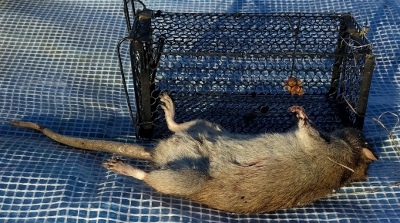
There is no way it would catch and hold a mouse, let alone a rat.
What home remedy can I use to get rid of rats?
Wire or steel wool is the only thing that stops rats in their tracks. Staple it to coop edges or over holes.
Other that wire wool there are none that work I'm afraid, there are plenty of old wives tails like:
Moth Balls. Mothballs tend to repel the rats.
Ammonia. Mix 2 spoons of detergent, a quarter glass of water and 2 cups of regular ammonia in a bowl.
Peppermint Oil. Peppermint oil can be used to prevent rats as they can't stand its pungent smell.
Owl's Feather, moth balls, ammonia, peppermint oil, herbs and capsaicin are all completely useless in controlling vermin.
How do you dispose of dead rats and mice?
Rats and mice, dead or alive, can carry fleas and infections that are dangerous to humans and other animals.
If killed by rodenticides, carcasses are likely to carry residues of rodenticides that can present serious risks to wildlife scavengers or predators.
Carcasses, bait stations and uneaten bait should be disposed of carefully and hygienically according to current legislation and the advice on rodenticide product labels.
For further advice contact the product manufacturer or your Local Authority.
Should you use a pest control agency or do it yourself?
You can do pest control yourself as long as you are careful. In most places the same poisons are available to the public that the professionals use.
If you are phobias of rodents or not happy dealing with rats then better use a professional. An pest controller is likely to be more costly and may only come once a month for example. They do however clean up the bodies of the rats so you won't have to.
There are plenty of good pest controllers about but the old adage, if you want something done properly then do it yourself, probably applies.
How do rats carry chicken eggs?
As a rule they don't carry them away. Eggs are eaten in situ if they can be. You do not carry you dinner away if you don't have too.
I have once seen a very large rat hold an egg to it's belly with it's front paws and run that way.
More often they will bite into it and carry or drag it into a burrow to finish it off.
They are extraordinarily adaptable and ingenious.
Do treadle feeders work for rats?
Below: A rodent in a treadle feeder.
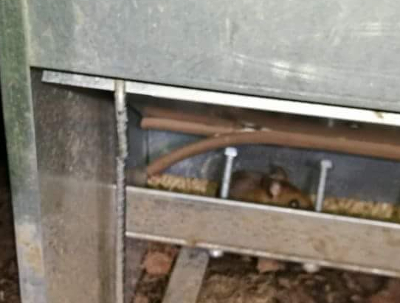
They are better than open feeders but a determined rats will get into a treadle feeder if it wants to.
Conclusion:
Rats need to be trapped and dealt with on a regular basis otherwise they get out of control and then become a problem. Use more than 1 method at a time to be sure.
